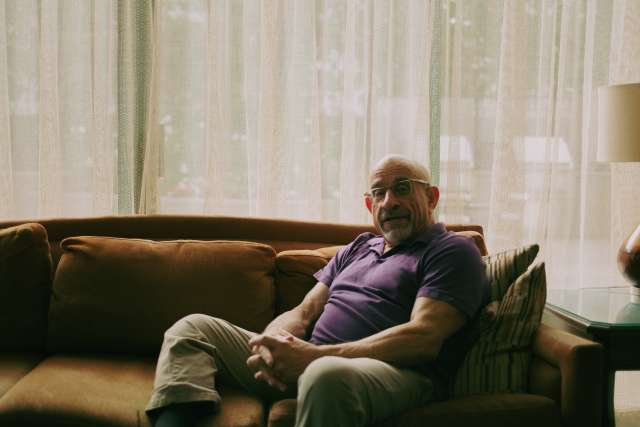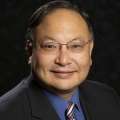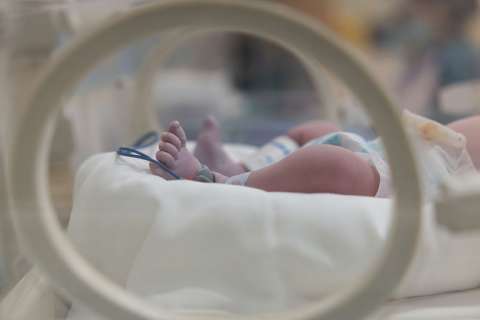When Tom Gillman and his partner opened Hardware, a small clothing shop on Melrose Avenue in late-1970s Los Angeles, it was an instant hit. And having spent weeks at a time in New York’s Fire Island Pines the previous six summers, their decision to open a seasonal shop there was a no-brainer.
In an era of rampant homophobia, Fire Island Pines was a gay mecca — a summer sanctuary where young gay men reveled on the beaches, boardwalks and at parties, unconstrained by the need to hide their identities. The two California men signed a three-year lease and opened Hardware @ the Pines in 1979, and with a wellheeled clientele that included fashion-industry leaders from all over the world, their first two summers were wildly successful.
But when Gillman and his partner arrived to prepare the business for its third season, just before Memorial Day weekend in 1981, something was amiss. A few stalwarts of the Pines community had died of unknown causes before the season began, and their absence was painfully conspicuous. “Throughout the Pines, there was a constant whisper of a ‘gay plague,’” Gillman recalls. That summer, thanks to his store’s close proximity to the site of the daily “tea dance” — a late-afternoon tradition in which hundreds of scantily clad revelers packed together and swayed to the thumping disco beat — Gillman remembers seeing several men who in prior years could be found in the center of the action suddenly taking to the sidelines.
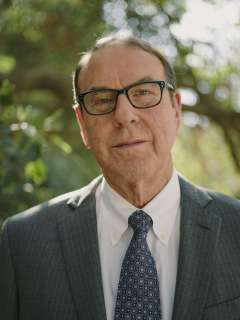
"They watched all the fun, making sure they weren’t noticed,” Gillman says. “If our eyes met for a second, they would look away. They dressed differently from the usual tea dance drag — maybe wearing long pants or long-sleeved shirts instead of shorts and tank tops. They concealed their faces with hats. They were, of course, covering up their Kaposi’s lesions while not wanting to miss being a little part of the heaven that Fire Island Pines unabashedly was before 1981.”
On the other side of the country, Michael Gottlieb, MD, a 32-year-old immunologist a few months into his career at UCLA, was frustrated. Recruited from Stanford, where he had just completed his fellowship training, Dr. Gottlieb had transferred his laboratory research program to L.A. But in the new environment, the experiments weren’t working. Dr. Gottlieb, who preferred patient care, anyway, began to spend more time on clinical pursuits.
In early 1981, as part of his efforts to teach his UCLA trainees about immunology, Dr. Gottlieb asked one of his fellows to poke around the wards for a patient whose illness showed unusual immunological features. The fellow learned from a medical intern of a previously healthy 31-year-old gay man who had come to the emergency room with weight loss, candidiasis (thrush) and persistent, unexplained fevers that ultimately developed into Pneumocystis carinii, a pneumonia previously understood to present only in individuals with severely compromised immune systems.
The patient’s symptoms didn’t comport with anything Dr. Gottlieb had encountered, and he thought one curious case might be an anomaly. That was until a rheumatologist at the Wadsworth VA who was moonlighting at a hospital in the San Fernando Valley told Dr. Gottlieb about two strikingly similar cases involving young gay men with the same rare pneumonia — both of them patients of a Sherman Oaks physician whose practice catered to the gay community.
At that time, few hospital laboratories had the capability to assay the health of a patient’s immune system. UCLA, on the other hand, had the Center for Interdisciplinary Research in Immunology and Disease, a federally funded facility that boasted the most state-of-the-art equipment available at that time. The chief of the lab was John L. Fahey, MD, who, while working for the National Institutes of Health (NIH) in the 1950s, made important discoveries that expanded scientific understanding of the human immune system. Now, Dr. Fahey turned his lab’s attention to the puzzle of the three young men with the baffling constellation of illnesses and discovered that they all had severely depleted CD4 T lymphocytes, a confirmation that their immune systems were profoundly weakened and no longer able to fight off infections that would not otherwise cause disease.
As word spread that Dr. Gottlieb was studying young gay men with a mysterious acquired immune deficiency, two more patients with the same cluster of symptoms were referred to UCLA.
On June 5, 1981, the Morbidity and Mortality Weekly Report of the U.S. Centers for Disease Control and Prevention (CDC) published a three-page report written by Dr. Gottlieb and four colleagues detailing the five cases. Titled simply “Pneumocystis Pneumonia — Los Angeles,” it was the first description of the disease that a year later would become known as acquired immune deficiency syndrome — AIDS.
Now the dam burst. The same day the report came out, a New York dermatologist contacted the CDC to report cases of Kaposi’s sarcoma (KS), an unusually aggressive cancer that forms masses in the skin, lymph nodes and other organs. Dr. Gottlieb began fielding calls from doctors from all over the country who wanted to know if their patients fit into the syndrome. By the end of the year, there were hundreds of confirmed cases in the United States.
The five cases of the yet unnamed syndrome first identified at UCLA presaged a global epidemic. Worldwide, approximately 80 million people have been infected by the human immunodeficiency virus (HIV), which was identified in 1983 as the agent that causes AIDS. HIV/ AIDS has taken an estimated 36 million lives.
No one in 1981 could have predicted such a devastating toll. But Dr. Gottlieb, who still is on faculty at UCLA, knew he had stumbled onto something big. “It was a bombshell,” he says. “And within the medical center, there was quite a bit of talk after the report” — which Dr. Gottlieb and his colleagues followed up on six months later with a more in-depth article in The New England Journal of Medicine — “that UCLA was on the cutting edge of this new, devastating disease.”
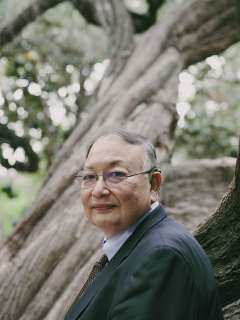
This year, as the world has struggled to claw its way out of the worst pandemic in a century, the HIV/AIDS epidemic quietly marked its 40th anniversary. The story of the last four decades includes shameful chapters — including the lackluster initial government response, irrational fears about transmission and ongoing marginalization and stigmatization of at-risk populations and the continuing failures of the U.S. health care system to meet the needs of communities of color and other underserved populations. But it also includes stories of humanity, perseverance and breathtaking scientific achievement. And in the 40 years since Dr. Gottlieb and his colleagues made their explosive report, UCLA has remained at the forefront of research and clinical advances that have transformed AIDS from a poorly understood disease associated with near-certain death to a treatable chronic illness for thve nearly 38 million people currently living with HIV — even if sizable challenges remain.
By early 1984, many of the people Tom Gillman knew were dying of AIDS. So, when he started to experience unexplained weight loss and blood in his stool, he didn’t hesitate to call his doctor. “I didn’t feel sick, but I knew that something was up. I just didn’t know what it was.” But after his doctor did an examination, “he knew,” Gillman recalls. “His face was ashen. I had Kaposi’s.” The physician told Gillman that he was referring him to another doctor at UCLA, Ronald T. Mitsuyasu, MD ’78 (FEL ’84). Dr. Mitsuyasu was starting his fellowship in hematology-oncology when Dr. Gottlieb reported the first cases. He recalls seeing his first AIDS patient in early 1982, and remembers the futility of the treatments. “Some of my more senior colleagues and mentors were saying this would pass, like any other viral infection, and I shouldn’t invest my career in this,” he recalls. “But to me, we were dealing with a disease that was far more serious than anything I had encountered before, and it was going to be around for a while.”
Dr. Mitsuyasu started seeing cancer patients with HIV, and he began a KS clinic in 1983. “The majority of patients were treated by practitioners in the community. We got the sickest ones and would do whatever we could to try to keep them alive. It was discouraging,” he says. “We had very few successes and a lot of deaths.”
Gillman would be one of the few early successes. “I was very nervous about that first visit,” he says. “All of a sudden, I was involved in something that was beyond my control, something much bigger than just myself. Yeah, I was very nervous.
Around the time Gillman began coming to UCLA, Dr. Mitsuyasu was starting an experimental protocol of interferon alpha, one of the first drugs tested for AIDS-related KS, and he enrolled Gillman into the trial. The treatment, which aimed to rev up the immune system, required Gillman to give himself a shot twice a day. The side effects were unpleasant — “It was really rough on me,” Gillman recalls — but after two six-week regimens, his KS lesions were gone.
While Dr. Mitsuyasu’s sense that AIDS would prove intractable came from his clinical experience, a UCLA colleague, Irvin S.Y. Chen, PhD, reached the same conclusion based on his training in the University of Wisconsin laboratory of Howard Temin, PhD, a Nobel laureate for his discovery of reverse transcriptase — the enzyme that would prove an important target for AZT, the first successful AIDS drug. When Dr. Chen arrived at UCLA in 1982, it wasn’t yet clear that a virus was the culprit in AIDS. That changed the next year with the identification of HIV, a retrovirus that reproduced using the reverse transcriptase enzyme. Because HIV turned out to be in the same family of viruses he had been studying, Dr. Chen became the first UCLA scientist to focus on HIV in the lab.
Within a decade, Dr. Chen would become the founding director of the UCLA AIDS Institute, a milestone for the university that brought to bear the wide-ranging expertise of nearly 200 faculty from all parts of the campus — in sharp contrast to the early days, when there were many basic logistical hurdles that had to be cleared. “The university wasn’t set up for this type of research, so there were all kinds of equipment and biosafety considerations to work out,” Dr. Chen says. But making that investment was essential. “I knew from working with these kinds of viruses that they were very difficult to deal with,” says Dr. Chen, who continues to head the institute.
Within a decade, Dr. Chen would become the founding director of the UCLA AIDS Institute, a milestone for the university that brought to bear the wide-ranging expertise of nearly 200 faculty from all parts of the campus — in sharp contrast to the early days, when there were many basic logistical hurdles that had to be cleared. “The university wasn’t set up for this type of research, so there were all kinds of equipment and biosafety considerations to work out,” Dr. Chen says. But making that investment was essential. “I knew from working with these kinds of viruses that they were very difficult to deal with,” says Dr. Chen, who continues to head the institute.
The challenges were also substantial outside of the patient-care and laboratory settings. “It became very clear there was little public awareness of the disease, and no political leadership focused on HIV at the national level,” Dr. Mitsuyasu says. He remembers joining with colleagues from other University of California campuses to lobby in Sacramento for funding from the state — an effort that led to the establishment in 1983 of the University-wide AIDS Research Program, which gave the UC campuses a jump in HIV/AIDS scientific and clinical endeavors. The same year, Dr. Mitsuyasu, Dr. Gottlieb and Yvonne J. Bryson, MD, a pediatric-infectious-diseases specialist, developed a research and clinical program in HIV, which later became the Clinical AIDS Research and Education (CARE) Center.
It was not until the AIDS diagnosis of actor Rock Hudson in 1984 and his death the following year that the public’s attention started to focus on the issue. As public awareness increased, so did research funding from the NIH. The CARE Center leaders were awarded a grant that made UCLA one of the first 14 centers in the country to have an AIDS evaluation and treatment unit, part of a network now known as the AIDS Clinical Trials Group (ACTG). With that, UCLA began conducting clinical trials of investigational drugs for HIV. One of the first involved the antiviral drug AZT, which showed benefits — bringing the first glimmer of hope, six years in.
As the epidemic unfolded, Roger Detels, MD, faced challenges of another type. An epidemiologist who was, at the time, dean of UCLA’s school of public health, Dr. Detels approached Drs. Gottlieb and Fahey with a proposal for a clinical, social and behavioral study to learn more about the causes of the lethal new disease and how best to prevent its spread within the population then known to be at the highest risk — men who had sex with men. For the study, Dr. Detels recruited students from UCLA’s Gay and Lesbian Association to anonymously fill out a questionnaire and allow their blood to be drawn to measure the level of their immune cells.
But Dr. Detels soon realized he would need to follow the students over time — potentially for years — which necessitated asking for their names and contact information. “There already was a high level of stigma against gay men, exacerbated to a huge extent by the appearance of this disease,” Dr. Detels recalled years later. “These young men were scared, and their natural inclination was to stay below the radar.” Nonetheless, of the 200 students who participated in the original study, 189 agreed to be followed. “That was, in my opinion, a colossal act of heroism,” says Dr. Detels, who today is Distinguished Professor of Epidemiology in the UCLA Fielding School of Public Health.
The research, still under Dr. Detels’ leadership, continues to this day as the UCLA site of the Multicenter AIDS Cohort Study (MACS). It has followed more than 2,000 participants and produced seminal findings on the epidemic. Later in the decade, Dr. Detels founded the UCLA/ Fogarty AIDS Training and Research Program, which prepared many of the public-health leaders in the fight against HIV/AIDS in China, Southeast Asia and India. Today, many of those leaders are spearheading the response to the coronavirus pandemic in their countries and at the World Health Organization.
From the first days of the epidemic, misinformation was widespread, including fears that HIV could be spread merely through touching or sharing utensils with an infected individual. Many health care providers refused to see HIV patients. “It was a primitive time,” Dr. Gottlieb says. “People were shunned and felt isolated.”
Gillman remembers that period in much blunter terms: “It was … terrible,” he says. “It was … war. It was hate. It was secrecy. It was drama. It was heartbreaking.”
When Dr. Mitsuyasu’s clinic was located in the basement of the UCLA Center for the Health Sciences — a difficult-to-find location with no sign on the door and no windows inside — some wondered if it was for fear of UCLA becoming too associated with HIV/AIDS care. But for patients like Gillman, who half-jokingly refers to the basement space as “the dungeon,” the discreet location had its benefits. “I wasn’t out to everybody about my diagnosis,” he says. “I didn’t want to be written off.”
Dr. Mitsuyasu remembers patients who went through the dying process alone because they hadn’t come out to their family and friends. In some cases, patients took him up on his offer to engage in frank discussions with their parents about what their HIV status meant. Dr. Mitsuyasu became skilled at preparing patients and their loved ones for death. “It was heartbreaking, but also rewarding, to be able to provide some comfort and help patients feel less isolated,” he says.
The desperation for more attention and funding to address a disease that was killing so many so quickly led many of UCLA’s AIDS clinicians and scientists to find common cause with the activists pushing for a more robust response. “Advocacy among patient groups is common now, but that really started with AIDS and members of the gay and lesbian community becoming organized and vocal,” Dr. Mitsuyasu says. “At first, they were hesitant about our involvement, but we worked to convince them we were on the same side, and that we would advocate with them for more federal support for research and services.”
Dr. Gottlieb felt that he had no choice but to enter the arena of political activism. “These early patients who were dying were my contemporaries,” he says. “Politically, there was a stigma associated with them, and so it was going to be an uphill fight. I felt I had to do what was necessary to plead with funders to take this seriously.”
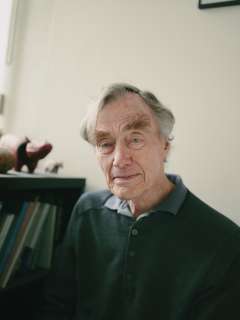
Dr. Gottlieb had treated Rock Hudson before his death, and together with actress Elizabeth Taylor and Dr. Mathilde Krim, a researcher at New York’s Memorial Sloan-Kettering Cancer Center, he co-founded the American Foundation for AIDS Research (amfAR). The foundation would become a world leader in supporting AIDS research and prevention, treatment, education and advocacy
Celebrity patients such as Hudson helped to put a recognizable human face on the disease, and celebrity activists like Taylor became invaluable allies in the quest for funding. Taylor was among the luminaries in attendance at the grand opening of the CARE Center’s current location, on Pico Boulevard, where she announced the creation of an endowment fund to support the center. Dr. Bryson — together with Dr. Gottlieb and pediatric immunologist E. Richard Stiehm, MD — was instrumental in the founding of the Elizabeth Glaser Pediatric AIDS Foundation in 1988, in partnership with the prominent activist, her husband and friends who sought to publicize the issue of AIDS and children after she contracted HIV through a blood transfusion during childbirth and unknowingly passed it to her daughter and son. “Elizabeth Glaser was amazing. She was a fierce mother bear, determined to make a difference in her lifetime, to see something change,” Dr. Bryson says. “What she was doing, going to Washington and capturing people’s attention, was inspirational. No one was paying attention to children at that time.” After living with AIDS for 13 years, Glaser died in 1994, at the age of 47.
When Dr. Gottlieb was trying to make sense of the initial cluster of cases in early 1981, he consulted with Dr. Bryson, a pediatric virologist who was also new to the UCLA faculty. At the time, it was very unclear what they were dealing with. “It wasn’t like any virus I had ever seen, but I told Michael that I wouldn’t be surprised if it was, in fact, a virus,” Dr. Bryson recalls. “What I didn’t anticipate then was how it was also going to affect mothers and children.”
Soon it became clear that was the case — first, when children were referred to UCLA with unusual illnesses that, Dr. Bryson and colleagues learned, stemmed from HIV infections traced to blood transfusions at birth; and then, with the initial reports of perinatal transmission from HIV-infected mothers. “I would see these babies coming in and getting so sick, with most of them dying before they were 2 years old, and then their mothers would die,” says Dr. Bryson, now a Distinguished Professor of Pediatrics and Infectious Diseases. “It became personal for me.”
It was evident to Dr. Bryson that protecting infants from HIV infection required administering antiviral treatment to the HIV-infected mother during pregnancy and at delivery, and then immediately to the newborn. But the idea of offering HIV tests to pregnant women and giving antiviral drugs to those who were infected was controversial. “It was a fight at every turn,” Dr. Bryson says. “Yet, without this, these babies were doomed to die.”
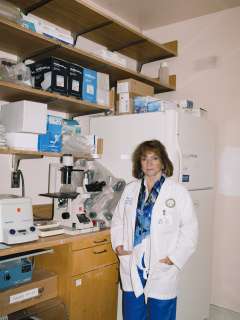
Ultimately, Dr. Bryson’s argument prevailed, leading to a landmark 1998 study she led that found giving AZT to the HIV-infected mother reduced the rate of perinatal transmission from 23% to 8%; with the advent of combination antiretroviral therapy, the risk would drop to 1.5%. “When I started working on prevention of perinatal transmission, I thought the best thing I ultimately could do was make myself not needed anymore. It’s gotten close to that point,” Dr. Bryson says. “I’ve seen children from infancy who grow up and have healthy babies of their own.”
Today, Dr. Bryson’s research is focused on the potential for HIV cure in infants. As far back as 1995, a group led by Drs. Bryson and Chen reported the first case of an infant clearing HIV from his body by his first birthday. Because HIV has a viral reservoir that is latent, adult patients with undetectable viral loads continue to be treated with antiretroviral drugs for life. “But it seems to be different in infants,” Dr. Bryson says. “We want to know whether or not if we treat them very early they might not need the drugs forever, giving the immune system a chance to grow normally.”
Dr. Bryson’s early work in preventing prenatal HIV transmission came at a time when combination antiretroviral therapy was changing the paradigm of HIV/AIDS treatment — providing the tools for AIDS to be treated as a chronic disease, and for patients to lead full lives. In Part 2 of this story, which will publish in the Winter 2022 issue of U Magazine, we highlight that transformation, as well as the formidable clinical, scientific and socioeconomic challenges that lie ahead.
